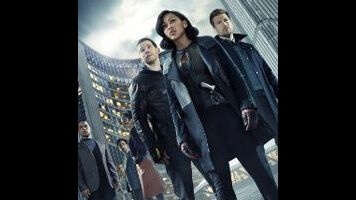Thirteen years after its theatrical release, the Steven Spielberg-Tom Cruise film Minority Report is an odd candidate for a TV sequel. Forming the middle act in Spielberg’s gloomy trilogy of early ’00s science-fiction blockbusters (falling between A.I. Artificial Intelligence and War Of The Worlds), the film was an artistic and commercial success, but its legacy is mostly summed up in smartphone swipes and a controversial ending. Diverging from its Philip K. Dick-penned source, the movie concludes on an up note, with the abolition of the predictive policing technique known as PreCrime and the liberation of the three clairvoyant “precogs” who made it possible.
Vega’s nostalgia for the PreCrime era and Dash’s faith in the technique puts the television series at odds with its cinematic and literary inspirations. The building blocks of their free-will-versus-determinism and perception-versus-reality debates are in place, but Dash’s desire to get back into law enforcement sets up a confused spectrum of morality for the small-screen Minority Report. Making a preemptive strike of its own, the pilot introduces the so-called Hawk-Eye initiative championed by mayoral candidate/former PreCrime bigwig Peter Van Eyck (Andrew Stewart-Jones), the digital crime deterrent of the NSA’s dreams. Straddling the line between Dash and Van Eyck is the second Precog twin, Arthur (Nick Zano), who’s gone capitalist with his ability to foresee the conclusion of a client’s life.
Minority Report is more faithful to its source material in its noisy, sensory-overloading vision of the near future. Animated advertisements litter the D.C. landscape, pushing everything from marijuana edibles to political candidates. The constant drone of public address systems become an additional vehicle for background information, each more or less intoning “It’s the future!” Elsewhere, indicators of the time period are laid on thick: A new, more sensitive nickname for Washington’s NFL franchise, characters with fetishes for 20th century antiques, and a legitimately clever Simpsons nod.
The symptom of this visual gimmickry is a depiction of a distracted world that similarly distracts the people making Minority Report. The action is constantly breaking for interludes from a selfie drone, the 2065 equivalent of FaceTime, or the myriad touch-screen doo-dads that the Minority Report film (to its credit) accurately presaged. In what appears to be a speculative-fiction victory lap, the pilot goes whole hog on the next generation of these technologies, giving Vega crime-scene-constructing contact lenses and running the actors through a carpal-tunnel-diagnosis’ worth of flicks, twists, and pinches. It’s nifty, but it’s all window dressing, and there’s no way it can be kept up on a weekly basis, lest the series join Almost Human on Fox’s costly dystopian-drama scrap heap. Then again, that show was a Warner Bros. production; this addition to Fox’s Officially Licensed Mondays keeps its expenses within the 20th Century Fox family.
Working their first case together, Vega and Dash barely spark—but Vega and her supervisor Lieutenant Blake (Wilmer Valderrama) do, so Dash gets his own Blake in the form of Zano’s Arthur. Failing to squeeze a Bones out of its leads from the get-go, Minority Report instead goes the Elementary route, setting Arthur up as the Mycroft to Dash’s Sherlock. Only Arthur gets the charisma of both Holmes brothers: Zano’s appearance in the pilot is brief (likely owing to his 11th-hour casting), but his smarmy charmer leaves an impression. Sands’ Dash is a frantic blank with muddled motivation; Zano injects some personality into the proceedings.
Unfortunately, that’s treating Minority Report’s antagonistic partnerships as a preloaded feature, rather than an update organically introduced down the line. A tense history is implied between Vega and Blake, but mostly in ways that force Valderrama into the role of Lieutenant Explainer from the Exposition Division. Unlike the show’s trio of siblings, the audience isn’t psychic, so everyone’s explaining what’s on their minds at all times. It’s an easy mistake that a lot of speculative fiction makes, erring too far in the direction of bringing everyone up to speed—with the world of 2065, but also the relationships that exist within that world. By the same token, the series kicks off with an interminable recap of the Spielberg movie, a Wikipedia summary gumming up an otherwise thrilling cold open. Like Vega and Dash building faith with one another, learning to trust the audience will be a big part of Minority Report moving forward.









































